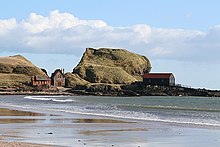Dunaverty Castle
Dunaverty Castle is a ruined castle in Southend at the southern end of the peninsula Kintyre in Scotland administrative unit Argyll and Bute . A Clan MacDonald fort was once located there . Today very little of it is preserved, the remains are considered a Scheduled Monument .
history
The remains of Dunaverty Castle lie on a rocky headland on the southeast corner of Kintyre. This headland forms a natural fortress surrounded on three sides by the sea and only accessible from the north. It is only connected to the mainland by a narrow strip of land. The castle was accessible via a drawbridge .
13th Century
In 1248 King Heinrich III. of England Walter Byset to buy supplies for Dunaverty Castle, which he had captured and just fortified, apparently in revenge for the hospitality that the Scottish King Alexander II had given certain English pirates . But in the same year the castle was taken by Allan , the son of the Earl of Atholl , and Byset was captured.
In 1263 Dunaverty Castle was built by King Alexander III. garrisoned during the Scottish-Norwegian war against King Håkon IV .
Later the castle had to surrender to the Norwegians, who in turn lent it to Dubhghall mac Ruaidhrí , one of their most steadfast supporters in the Hebrides . With the disappearance of Norwegian supremacy in the Hebrides after 1263, Alexander III. to have recaptured the castle.
14th Century
At the end of 1306, King Robert the Bruce appears to have taken shelter at Dunaverty Castle. According to the heroic poem The Brus , the king stayed there for three days with Aonghus Óg Mac Domhnaill before sailing on to Rathlin Island. However, contemporary sources reveal that the castle was already under the control of the king; the king had acquired it in March from a certain Maol Coluim . In September of that year the castle had to surrender to an English siege, but the Scottish king was nowhere to be found.
15th century
In 1493 the fourth and last Lord of the Isles forfeited his title to King James IV. In 1494 the King garrisoned Dunaverty Castle and provided it with food. It is said that the MacDonalds, led by Sir John MacDonald , whom the king had recently knighted, recaptured the castle before the king had left for Stirling , and that the body of the royal governor of the castle over the castle wall in Visibility of the king and his retreating entourage was hanged. Sir John MacDonald was later captured by MacIain of Ardnamurchan . He was tried and hanged in Burgh Muir near Edinburgh .
16th Century
Between 1539 and 1542 the castle was repaired on behalf of the Crown. In January 1544 the captain, constable and governor of Dunaverty Castle, in Maria Stuart's name, was commissioned to deliver the castle with its artillery and ammunition to the Earl of Argyll , and in April of that year the Earl of Argyll was given a 12-year lease North and South Kintyre, including the castle. In 1588 Dunaverty Castle was attacked by the Earl of Surrey , but did not cause any damage.
17th century
In 1626 the Lordship of Kintyre was rebuilt in favor of the Earl of Argyll and Dunaverty Castle was designated as the headquarters. The Earl of Argyll bequeathed the Lordship of Kintyre to John , his eldest son by second marriage, who chartered it in Dunaverty in 1635 to Viscount Dunluce , the eldest son of Randal MacDonnell, 1st Earl of Antrim . This transfer was not confirmed by the Scottish Privy Council , no doubt at the instigation of the Earl of Argyll's first marriage, the Marquis of Lorn , who bitterly disapproved of his father's legacy of lordship to his younger half-brother. On December 12, 1636, the Marquis of Lorn received a charter with the Great Seal over the Lordship of Kintyre with Dunaverty Castle as its headquarters.
During the Civil War , Dunaverty Castle was besieged in 1647 by Scottish supporters of Oliver Cromwell , under the leadership of General David Leslie (Leslie later became a royalist ). The McDonalds surrendered, and then 300 of them were massacred. This incident became known as the Battle of Dunaverty or the Dunaverty Massacre . Today the castle is only a ruin, which is also called Blood Rock because of the massacre .
Individual evidence
- ↑ Dunaverty Castle. In: Canmore. Royal Commission on the Ancient and Historical Monuments of Scotland, accessed June 23, 2017 .
- ↑ Scheduled Monument - Entry . In: Historic Scotland .
- ^ GWS Barrow : Kingship and Unity: Scotland 1000-1306. University of Toronto Press, Toronto 1981, OCLC 803443558 , p. 120.
Coordinates: 55 ° 18 '27 " N , 5 ° 38' 40.9" W.
